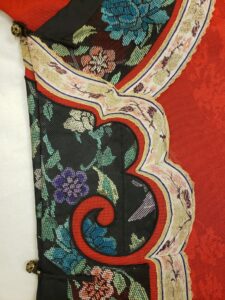Story by Megan Osborne, Assistant Curator and Collections Manager
The Colorado State University Avenir Museum of Design and Merchandising recently received a beautiful Manchu woman’s silk robe as a donation to the permanent collection.
Historical background

The Qing Dynasty (1644-1911) of China was founded by a northeast Asian people who called themselves Manchu. Their cultural and linguistic identity was distinct from the ethnic Han Chinese population. The Manchu people came to power in the mid-17th century and built the final imperial dynasty of China, holding power until 1911.
Fashions from the period of Manchu rule moved away from the stylistic traditions of the Han people and began to take on a new and distinct appearance. The most noticeable difference was a change in the cut of formal and semi-formal robes worn by both men and women. The robes were fastened along the right side of the body from the neckline closing diagonally toward the right shoulder. The long robe also began to feature slits at the bottom to facilitate ease of movement.
Manchu women’s robes more than men’s borrowed from the Han style. The sleeve shape is an example of this exchange. Han robes featured wide sleeves that were adapted into more informal everyday garments worn by Manchu women. The primary difference between the two was the length or the robe — while Han women continued to wear short kaftans over skirts, the Manchu women’s robe was long and worn over a skirt and later over pants.
Manchu silk robe

The Manchu woman’s silk robe donated to the Avenir dates to the late 19th -early 20th century. The body of the robe is woven from bright red silk patterned with a subtle repeating floral medallion. The robe closes with four small metal buttons and silk loop closures evenly spaced from the center of the neckline across the right side of the body to just under the right shoulder.
The black trim around the neckline and perimeter of the robe has been embroidered with a garden of flowers and butterflies, the same design is replicated on the lowest part of the sleeve cuff with the flowers and butterflies landing on a woven white ground. An applique of floral-patterned silk ribbon with gold edging winds around the black embroidered trim and help to set off the distinct neckline and curvilinear design typical of Qing design style.
Donor: Sophie and Theodore Aldrich
Avenir Museum Permanent Collection 2024.2.1
The Avenir Museum is in the Department of Design and Merchandising, part of CSU’s College of Health and Human Sciences.